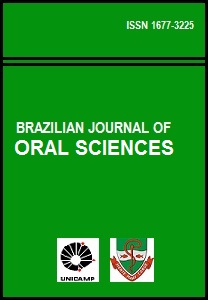Abstract
This paper first provides a review of the anatomy and physiology of striated muscles, focusing on the muscle fiber, motor unit and µ neuron. We also commented on the factors that affect the depolarization of this neuron, resulting in its excitation or inhibition, and thereby altering the contractions of the motor unit, which in turn alters the equilibrium of the muscle dynamics. The changes caused by these factors, such as muscular hyperactivity, found mainly in the temporal muscles, with the jaw the resting position and chewing are also discussed. However, muscular hypoactivity is most frequently observed in the masseter muscles. The suprahyoid muscles, responsible for the positioning of the tongue, also show a large number of alterations. We also commented on the changes observed in the contractions of the posterior cranio-cervical musculature, sternocleidomastoid muscles and the upper fibers the trapezius, which are sources of referred pain.References
Moyers R E. Temporomandibular Muscle Contraction Patterns in Angle Class II, Division I Malocclusion: An Electromyographic Analysis. Am J Orthod. 1949; 35: 837-57.
Biomedcal and Health Research Program. Seniam. European Recommendations for Surface Electromyography. Viena: Roessingh Research and Development; 1999.
Basmajian JV, De Luca CJ. Muscles Alive: Their functions revealed by electromyography. 5.ed. Baltimore: Williams & Wilkins; 1985. p.469.
Jankelson RR. Neuromuscular dental diagnosis and treatment. Saint Louis: Ishiyaku EuroAmerica Publishers; 1990.
Sherrington CS. The integrative action of the nervous system. 2.ed. Han Haven: Yale University Press; 1906.
Stolov WC. The concept of normal muscle tone, hypotonia and hypertonia. Arch. Phys. Med. 1966; 47.156-68.
Kawamura Y, Fujimoto J. Some physiologic considerations on measuring rest position of the mandible. Med J Osaka Univ. 1957; 8: 247.
Hickey JC. Stability of mandibular rest position. J Prosthet Dent. 1961; 11: 566.
Rugh JD, Drago CJ. Vertical dimension: a study of clinical rest position and jaw muscle activity. J Prosthet Dent. 1981; 2: 670.
Ferrario V F, Sforza C, Miami A, D’addona A, Barbini E. Electromyographic activity of masticatory muscles in normal young people: statistical evaluation reference values for clinical applications. J Oral Rehabil. 1993; 20: 271.
Faria CRS, Bérzin F. Electromyographic study of the temporal, masseter and suprahyoid muscles in the mandibular rest position. J Oral Rehabil. 1998; 25: 776-80.
De Luca CJ. The use of surface electromyography in biomechanics. J Appl Biomech. 1997; 13: 135-63.
Biasotto D A. EMG study of muscles of the mastigation during chewing differents materialis [Master’s thesis]. Piracicaba: FOP/ UNICAMP; 2000.
Rodrigues D, Oliveira AS, Bérzin F. Electromyographic study of the masticatory muscles activity with jaw in rest position, in temporomandibular joint disorder (tmd) patients, with myofascial pain. In: Annals of 5th Brazilian Symposium and International Meeting of Pain. São Paulo; 2001. p.302.
Bérzin F. Electromyographic study of hyperactivity of the masticatory muscles in temporomandibular joint disorder (TMD) patients. In: Annals of 4th Brazilian Symposium and International Meeting of Pain. São Paulo; 1999. p.405.
Bérzin F. Electromyographic study of hypoactivity of the masticatory muscles in temporomandibular joint disorder (TMD) patients with myofascial pain. In: Annals of 5th Brazilian Symposium and International Meeting of Pain. São Paulo; 2001. p.292.
Semeghini TA, Duarte CL, Bérzin F. Electromyographic evaluation of craniocervical muscles in temporomandibular joint disorder patients (TMD). In: Annals of 5th Brazilian Symposium and International Meeting of Pain. São Paulo; 2001. p.293.
Cram JR, Kasman GS, Holtz J. Introduction to surface electromyography. Gaithersburg: Aspen Publication; 1998.
Oliveira AS. Multifactorial characterization of a temporomandibular joint disorder patients population. [Doctor’s Thesis]. Piracicaba: FOP/UNICAMP; 2002.
The Brazilian Journal of Oral Sciences uses the Creative Commons license (CC), thus preserving the integrity of the articles in an open access environment.

